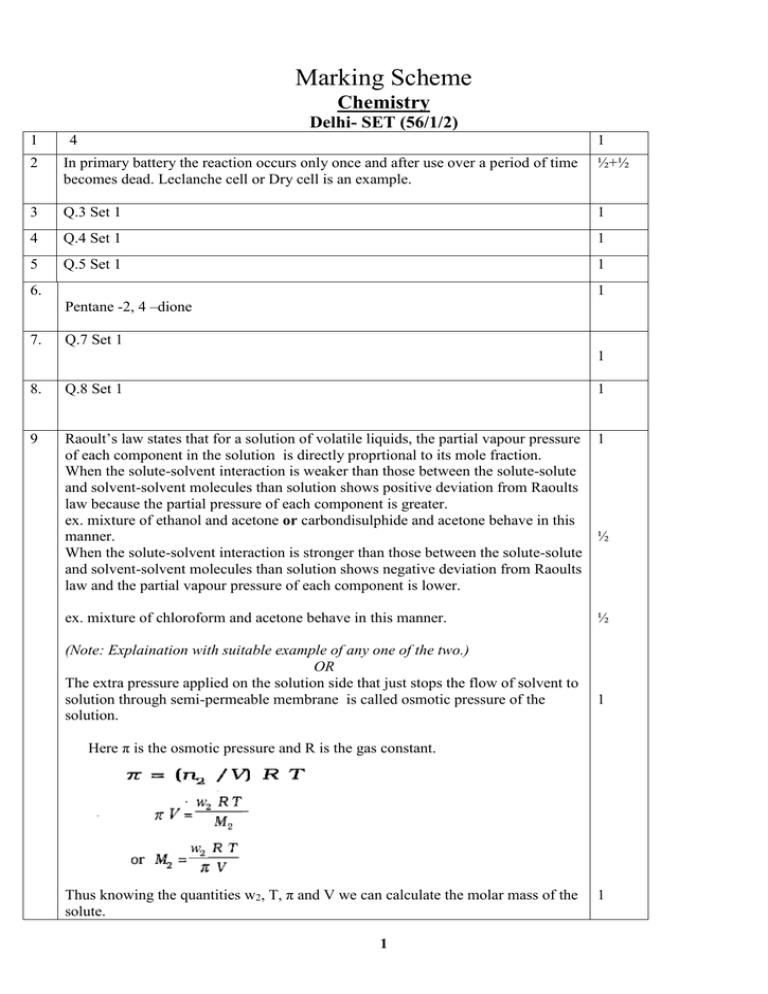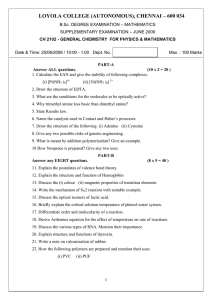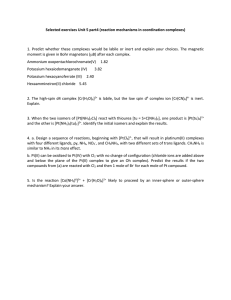Marking Scheme Chemistry Delhi- SET (56/1/2)
advertisement

Marking Scheme Chemistry Delhi- SET (56/1/2) 1 4 1 2 In primary battery the reaction occurs only once and after use over a period of time becomes dead. Leclanche cell or Dry cell is an example. ½+½ 3 Q.3 Set 1 1 4 Q.4 Set 1 1 5 Q.5 Set 1 1 6. 1 Pentane -2, 4 –dione 7. Q.7 Set 1 1 8. Q.8 Set 1 1 9 Raoult’s law states that for a solution of volatile liquids, the partial vapour pressure 1 of each component in the solution is directly proprtional to its mole fraction. When the solute-solvent interaction is weaker than those between the solute-solute and solvent-solvent molecules than solution shows positive deviation from Raoults law because the partial pressure of each component is greater. ex. mixture of ethanol and acetone or carbondisulphide and acetone behave in this manner. ½ When the solute-solvent interaction is stronger than those between the solute-solute and solvent-solvent molecules than solution shows negative deviation from Raoults law and the partial vapour pressure of each component is lower. ex. mixture of chloroform and acetone behave in this manner. (Note: Explaination with suitable example of any one of the two.) OR The extra pressure applied on the solution side that just stops the flow of solvent to solution through semi-permeable membrane is called osmotic pressure of the solution. ½ 1 Here π is the osmotic pressure and R is the gas constant. Thus knowing the quantities w2, T, π and V we can calculate the molar mass of the solute. 1 1 10 m = x 1000 cm3L-1 c = 0.0248 S cm-1 x 1000 cm3 L-1 0.20 mol L-1 1 = 24.8 S cm2 0.20 mol m = 124 Scm2 mol-1 11 1 The galvanic cell is depicted as: Zn(s) Zn2+(aq) Ag+(aq)Ag (s) (i) Zinc electrode is negatively charged (ii) The ions formed i.e Zn2+ and Ag+ in the solution are the carriers of the current within the cell. (iii) At anode: Zn(s)Zn2+(aq) + 2e- At cathode: 2Ag+(aq)+ 2e- 2Ag(s) ½ ½ ½ ½ 12 Q.14 Set 1 2 13 Q.15 Set 1 2 14 (i) (ii) 1+1 15 C6H5I + KCl + N2 BrCH2-CH2Br (i) Aryl halides are less ractive towards nucleophilic substitution because of any of the following reasons (i) Resonance effect stabilization (ii) sp2 hybridization in haloarenes and sp3 in haloalkanes. (iii) Instability of phenyl cation (iv) possible repulsion (ii) 1 Cl Undergoes SN1 reaction faster because of the stability of secondary carbocation. ½+½ 16 17 Q.18 Set 1 Q.16 Set 1 2 2 18 Q.17 Set 1 2 19 20 21 Q.21 Set 1 Q.20 Set 1 Q.19 Set 1 3 3 3 2 22 23 24 25 26 27 28 Q.23 Set 1 Q.22 Set 1 Q.26 Set 1 Q.27 Set 1 Q.25 Set 1 Q.24 Set 1 (a) Half life of a First order reaction: 3 3 3 3 3 3 * 1/2 1/2 0 1 (b) 2NH3 (g) Rate = N2 (g) +3 H2(g) -d[NH3] =k[NH3]O = 2.5 x10-4Ms-1 dt 1 - 1 d[NH3] = + d[N2] = + 1 d[H2] 2 dt dt 3 dt Rate of production of N2 = + d[N2] = - 1 [NH3] dt 2 dt = 1 x (2.5 x 10-4 Ms-1) = 1.25 x 10-4 Ms-1 2 Rate of production of hydrogen = d[H2] = - 3 [NH3] dt 2 dt = 3 x (2.5 x 0-4 Ms-1) 2 = 3.75 x 10-4 Ms-1 1 1 or Rate = Rate = 1 -d[NH3] =k[NH3]O = 2.5 x10-4Ms-1 dt - 1 d[NH3] = + d[N2] = + 1 d[H2] 2 dt dt 3 dt Rate of production of N2 = + d[N2] = Rate= 2.5 x10-4Msdt 3 1 Rate of production of hydrogen = d[H2] = 3 x Rate dt = 3 x (2.5 x 0-4 Ms-1) = 7.5 x 10-4 Ms-1 (Note: No marks to be deducted for wrong unit in this question,as there is a misprint in the question in units of k) or (a)Factors affecting rate of chemical reaction are: (i)Concentration of reactants (ii)Temperature (iii)Presence of catalyst (iv)Surface Area (v)Activation energy (any four) = (b) k 0.693 t1/2 = k 0.693 5730 y K = 1.21 x 10-4 y-1 t = 2.303 k log [ A0 ] [A] 1 ½x4=2 ½ ½ 1 k = 2.303 log 100 -4 -1 1.21 x 10 y 80 k= 2.303 log 1.25 -4 -1 1.21 x 10 y k= 2.303 x 0.0969 -4 -1 1.21 x 10 y = 1845 years 1 4 29 * 1x3=3 (or any other suitable method) (a) (i)Decarboxylation: Carboxylic acids lose carbon dioxide to form hydrocarbons when their sodium salts are heated with sodalime.The reaction is known as decarboxylation. R-COONa NaOH & CaO R-H + Na2CO3 Heat (ii) Cannizzaro reaction: Aldehydes which do not have an α-hydrogen atom, uhdergo self oxidation and reduction reaction on treament with concentrated alkali. ( or any other suitable reaction) (Note: Award full marks for correct chemical equation;award ½ mark if only statement is written) 5 1+1 OR (a) (i) C H O 69.77/12 11.63/1 18.60/16 5.81 11.63 1.16 5.81/1.16 11.63/1.16 1.16/1.16 5 10 1 Empirical formula C5H10O,empirical formula mass 60+10+16=86 1 Hence, Mol formula C5H10O It is a ketone as it appears from its reactions which on oxidation 1 gives ethanoic and propanoic acids, hence the compound is 1 CH3COCH2CH2CH3 (b)(i)Because the stability of conjuguate base of monochloroethanoic acid is less due to presence of one electron withdrawing -Cl group than in dichloroethanoic acid. (ii)This is because of greater electronegativity of sp2 hybridised carbon to which carboxyl carbon is attached. ( or any other suitable reason) 30 Q.29 Set 1 1+1 5 6



